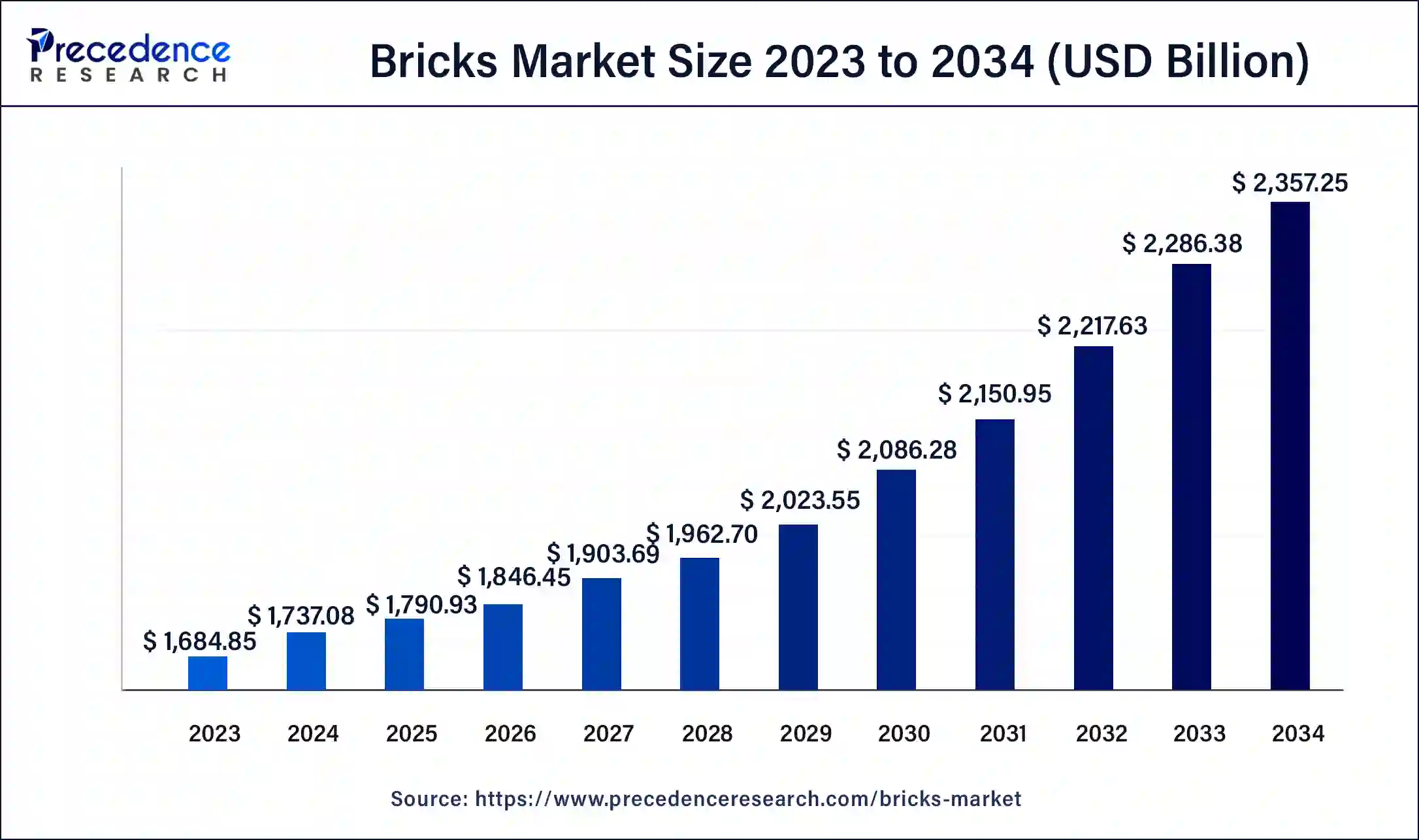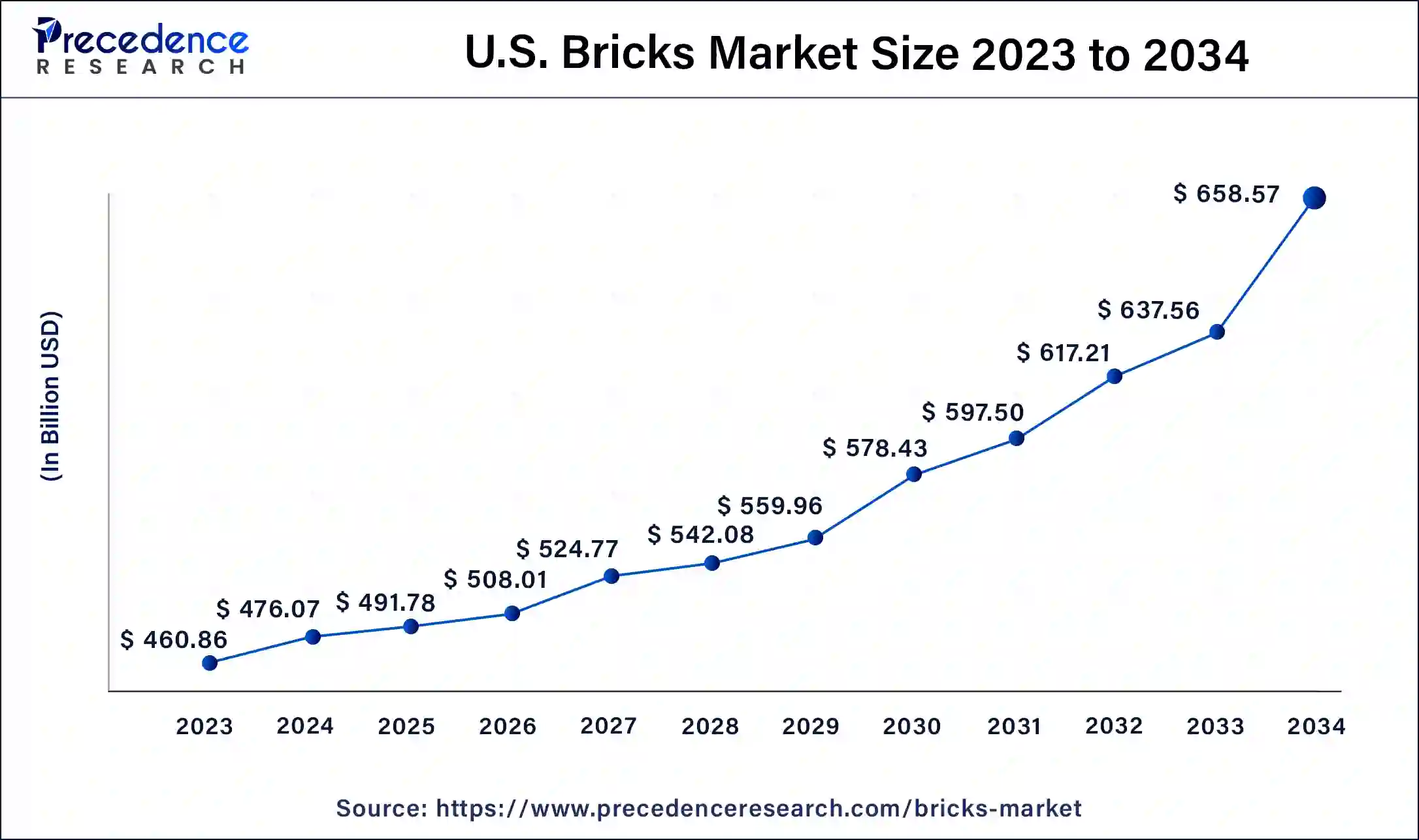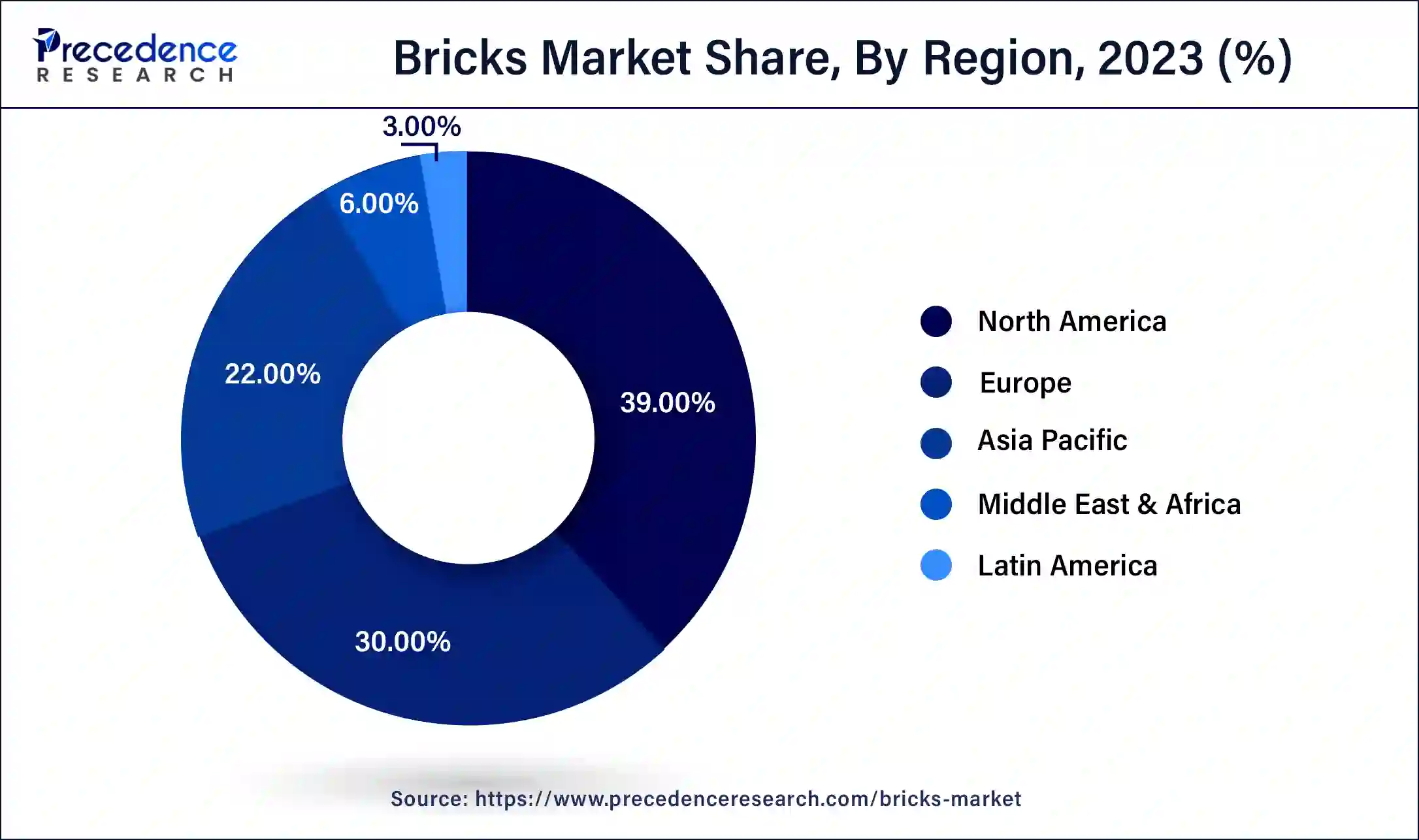July 2024
The global bricks market size was USD 1,684.85 billion in 2023, calculated at USD 1,737.08 billion in 2024 and is projected to surpass around USD 2,357.25 billion by 2034, expanding at a CAGR of 3.1% from 2024 to 2034.
The global bricks market size accounted for USD 1,737.08 billion in 2024 and is expected to be worth around USD 2,357.25 billion by 2034, at a CAGR of 3.1% from 2024 to 2034. The North America bricks market size reached USD 657.09 billion in 2023.

The U.S. bricks market size was estimated at USD 460.86 billion in 2023 and is predicted to be worth around USD 658.57 billion by 2034, at a CAGR of 3.3% from 2024 to 2034.

North America holds a major share of 39% in the bricks market due to a mature construction sector and a strong emphasis on sustainable building practices. The region's well-established infrastructure and a growing trend towards eco-friendly construction contribute to the steady demand for bricks. Additionally, stringent building codes and regulations promoting energy-efficient materials further drive the adoption of bricks. With a focus on durability and resilience, North America continues to be a significant market for bricks, particularly in residential and commercial construction projects.
Asia-Pacific is poised for rapid growth in the bricks market due to burgeoning urbanization, extensive infrastructure projects, and increased construction activities. The region's robust economic development has led to a surge in demand for affordable housing and commercial spaces, driving the need for construction materials like bricks. Moreover, supportive government initiatives, coupled with a rising population, contribute to sustained growth. The construction boom in countries such as China and India further solidifies Asia-Pacific as a key market for bricks, with the potential for continued expansion in the future.

Meanwhile, Europe is experiencing notable growth in the bricks market due to a resurgence in construction activities, driven by urban development projects and infrastructure investments. The region's focus on sustainable and energy-efficient construction aligns with the eco-friendly attributes of modern bricks. Additionally, stringent building regulations promoting durability and thermal insulation contribute to increased brick usage. As European countries prioritize environmentally conscious building practices, the demand for bricks, with their versatility and green building potential, continues to grow, reflecting the region's upward trajectory in the market.
Bricks are rectangular building materials typically made of clay, shale, or concrete, which are widely used in construction for centuries. These versatile units serve as the fundamental building blocks for structures ranging from simple walls to elaborate architectural designs. The production process involves molding the raw materials, followed by drying and firing in kilns to achieve durability and strength. Bricks come in various types, including common bricks for general use, firebricks for high-temperature applications, and specialized bricks with specific characteristics. Their modular size and uniformity facilitate easy assembly, making them a preferred choice for constructing load-bearing walls, facades, and pavements.
Beyond their structural utility, bricks also contribute to aesthetic appeal, with different colors, textures, and finishes available. Modern construction techniques incorporate innovative materials, such as interlocking bricks or those made from recycled materials, to enhance sustainability. Despite advancements in construction technology, traditional bricks continue to play a crucial role in the global building industry, symbolizing resilience and endurance in architectural heritage.
| Report Coverage | Details |
| Market Size in 2023 | USD 1,684.85 Billion |
| Market Size in 2024 | USD 1,737.08 Billion |
| Market Size by 2034 | USD 2,357.25 Billion |
| Growth Rate from 2024 to 2034 | CAGR of 3.1% |
| Largest Market | North America |
| Base Year | 2023 |
| Forecast Period | 2024 to 2034 |
| Segments Covered | By Brick Type, By Size, and By Application |
| Regions Covered | North America, Europe, Asia-Pacific, Latin America, and Middle East & Africa |
Urbanization trends
Urbanization trends significantly drive market demand for bricks as the global population increasingly gravitates towards urban areas. With over half the world residing in cities, urbanization fuels a surge in construction projects, emphasizing the need for durable and versatile building materials like bricks. As cities expand, there is a growing requirement for residential and commercial infrastructure, resulting in a consistent demand for bricks in housing developments, office complexes, and other urban structures.
Moreover, the trend towards vertical urbanization, seen in the construction of high-rise buildings, further amplifies the reliance on bricks as a fundamental construction material. Bricks provide structural integrity, fire resistance, and insulation essential qualities in dense urban environments. The ongoing urbanization trajectory is, therefore, a pivotal factor propelling sustained growth in the bricks market, aligning with the dynamic needs of modern urban development.
Lack of innovation
The bricks market faces a significant restraint in the form of a lack of innovation in manufacturing techniques and designs. Traditional brick production methods have seen limited advancements, potentially hindering the market's ability to meet evolving demands in the construction industry. The absence of innovative approaches in material composition, energy efficiency, and sustainable practices may make bricks less attractive to architects, builders, and developers seeking modern, eco-friendly solutions.
In an era where construction trends are shifting towards green building practices and cutting-edge design aesthetics, the lack of innovation in the bricks market poses a challenge. Failure to incorporate technological advancements and adapt to changing architectural preferences may result in a diminished market share as alternative materials that offer greater versatility, sustainability, and energy efficiency gain prominence in the construction sector.
Architectural innovation
Architectural innovation is creating significant opportunities in the bricks market by redefining traditional construction practices. Collaborations between architects and brick manufacturers have led to the development of innovative designs that go beyond conventional rectangular shapes. Bricks are now available in unique forms, sizes, and textures, allowing architects to explore creative possibilities in modern construction.
Moreover, the demand for sustainable and energy-efficient building materials has prompted architectural innovation in brick manufacturing. Eco-friendly bricks, incorporating recycled materials or utilizing low-carbon production processes, align with green building initiatives. These advancements not only cater to evolving architectural preferences but also position bricks as a versatile and environmentally conscious choice in contemporary construction, making way for market expansion and capturing the attention of architects, builders, and environmentally conscious consumers alike.
The clay bricks segment had the highest market share of 41% in 2023. Clay bricks, a fundamental category in the bricks market, are crafted from natural clay, typically through the firing process. These bricks are renowned for their durability, thermal insulation properties, and traditional aesthetic appeal, making them a staple in construction. The clay bricks segment is witnessing a resurgence in demand due to sustainable practices. Manufacturers are exploring energy-efficient kiln technologies and incorporating recycled content, aligning with the industry's green initiatives. This trend reflects a growing preference for eco-friendly materials in the construction sector.
The concrete segment is anticipated to expand at a significant CAGR of 4.1% during the projected period. In the bricks market, the concrete segment refers to bricks manufactured from cement, aggregates, and water. Concrete bricks offer durability, strength, and a versatile aesthetic. A prominent trend in the concrete brick segment is the increasing preference for precast concrete bricks, which are manufactured off-site and transported for construction. This trend aligns with the growing demand for efficient and sustainable construction practices, as precast concrete bricks reduce on-site labor requirements and enhance construction speed, making them a popular choice in the contemporary building industry.
The standard segment held a 48% market share in 2023. In the bricks market, the standard segment pertains to widely adopted sizes conforming to industry standards. Common sizes include modular (7 5/8 x 3 5/8 x 2 1/4 inches), queen (7 5/8 x 2 3/4 x 2 3/4 inches), and king (9 x 2 5/8 x 2 3/4 inches). A prevailing trend favors modular bricks for their user-friendly dimensions, reflecting contemporary construction preferences that prioritize efficiency and standardized sizing in the industry.
The modular segment is anticipated to witness rapid growth over the projected period. In the bricks market, the modular segment refers to bricks that adhere to standardized dimensions, facilitating easy and precise construction. This segment is characterized by uniformity in size, allowing for efficient assembly and reducing construction time. A notable trend in the modular bricks market is the increasing preference for these standardized units, driven by their versatility in various construction applications. The modular segment's growth is attributed to its convenience, cost-effectiveness, and compatibility with contemporary construction methods, reflecting a shift towards streamlined and efficient building practices.
According to the application, the residential building segment held a 32% revenue share in 2023. The residential building segment in the bricks market refers to the use of bricks in the construction of houses and residential complexes. A notable trend in this segment is the growing preference for bricks in sustainable and energy-efficient housing projects. Architects and builders are increasingly incorporating innovative brick designs and eco-friendly materials to meet the demand for aesthetically pleasing yet environmentally conscious residential structures. This trend aligns with the global emphasis on green building practices, positioning bricks as a key material for sustainable residential construction.
The infrastructure segment is anticipated to expand fastest over the projected period. In the bricks market, the infrastructure segment refers to the application of bricks in large-scale construction projects, including roads, bridges, and public utilities. A prevailing trend in this segment involves the increasing preference for durable and cost-effective materials, positioning bricks as a fundamental choice for infrastructure development. The robust nature of bricks makes them well-suited for heavy-duty applications, contributing to the resilience and longevity of infrastructure projects globally. This trend is particularly notable as governments invest in extensive infrastructure initiatives to support economic growth and urban development.
Segments Covered in the Report:
By Brick Type
By Size
By Application
By Geography
For inquiries regarding discounts, bulk purchases, or customization requests, please contact us at sales@precedenceresearch.com
No cookie-cutter, only authentic analysis – take the 1st step to become a Precedence Research client
July 2024